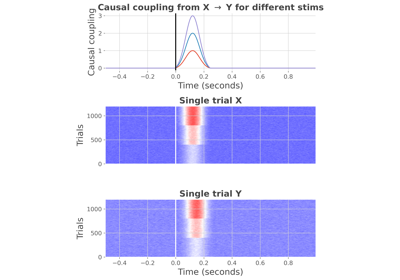frites.conn.conn_fit#
- frites.conn.conn_fit(data, y, roi=None, times=None, mi_type='cc', gcrn=True, max_delay=0.3, avg_delay=False, net=False, sfreq=None, verbose=None, **kw_links)[source]#
Feature-specific information transfer.
- Parameters:
- datanumpy:array_like
Electrophysiological data. Several input types are supported :
Standard NumPy arrays of shape (n_epochs, n_roi, n_times)
mne.Epochs
xarray.DataArray of shape (n_epochs, n_roi, n_times)
- ynumpy:array_like
The feature of shape (n_trials,). This feature vector can either be categorical and in that case, the mutual information type has to ‘cd’ or y can also be a continuous regressor and in that case the mutual information type has to be ‘cc’
- roinumpy:array_like |
python:None Array of region of interest name of shape (n_roi,)
- timesnumpy:array_like |
python:None Array of time points of shape (n_times,)
- mi_type{‘cc’, ‘cd’}
- Mutual information type. Switch between :
‘cc’ : if the y input is a continuous regressor
‘cd’ : if the y input is a discret vector with categorical integers inside
- gcrnbool |
python:True Specify if the Gaussian Copula Rank Normalization should be applied. Default is True.
- max_delay
python:float| .3 Maximum delay for past conditioning
- avg_delaybool |
python:False If False (default) the returned FIT is aggregated across delays. If True, the returned FIT is going to contained the additional dimension corresponding to the number of delays used.
- sfreq
python:float|python:None The sampling frequency.
- kw_links
python:dict| {} Additional arguments for selecting links to compute are passed to the function
frites.conn.conn_links()
- Returns:
- fitnumpy:array_like
The feature specific information transfer of shape (n_pairs, n_times) if avg_delay is False or (n_pairs, n_delays, n_times) if avg_delay is True.
See also
References
Celotto M, et al. [3]
